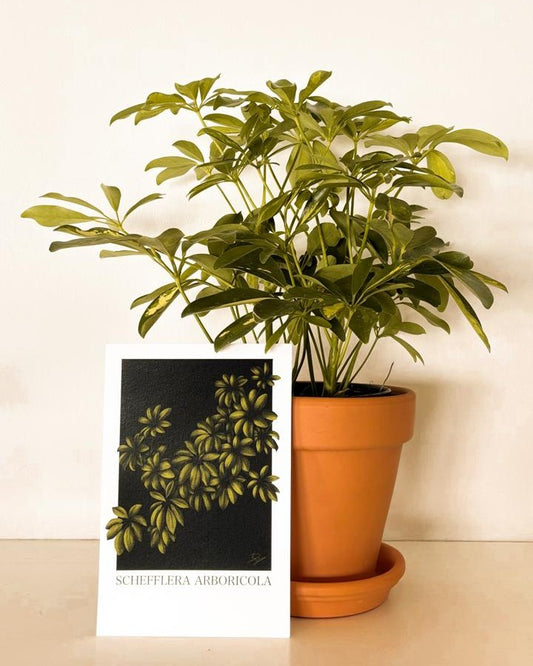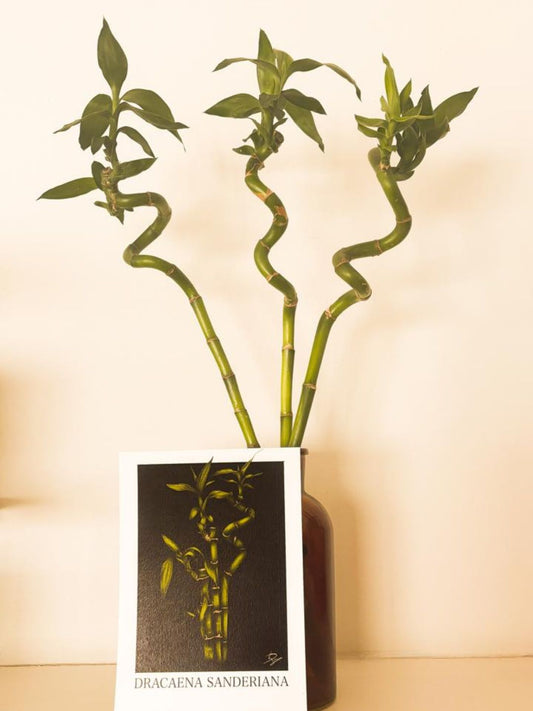To be completely honest, I am not a huge cacti fan. I don’t know if it’s their rigid appearance or the fact that they can literally be used as weapons, but I’ve just never been drawn to them. Apart from one: the fishbone cactus. There’s just something very alluring about it, with its interesting architectural shape and squiggly patterns.

It’s such a statement houseplant that is not only stunning but also, being a cactus, one of the easiest plants to care for. Let’s take a look at the characteristics of the fishbone cactus, how to properly care for it, and the most challenging part: how to style it.
Botanical Name |
Epiphyllum anguliger |
Plant Family |
Cactaceae |
Common Name |
Fishbone cactus/Zig-zag cactus/Ric-rac cactus/Orchid cactus |
Size |
Length: 30 to 100cm Width: 30 to 60 cm |
Soil |
Well draining succulent mix |
Mother Country |
Mexico |
Toxicity |
Non-toxic |
Origins & Natural Habitat

Being a cactus, you would think that the fishbone cactus’ natural habitat is the desert, but unlike its cactus cousins, it actually originates from the dense tropical rainforests of Mexico. Also unlike most cacti, the fishbone cactus is an epiphyte, which means that it grows on other plants and draws moisture from the air.
Botanical Background

The fishbone cactus is part of the Cactaceae family and is scientifically known as Epiphyllum anguliger. Because of its flat shape and zig-zag pattern, the fishbone cactus is often referred to as the zig-zag cactus, ric-rac cactus, or orchid cactus. Just by looking at it, you would never guess, but the fishbone cactus produces large, stunning pink or white blooms that emit the sweetest of fragrances.
Care Tips for a Thriving Fishbone Cactus

I know what you’re thinking, and just for the record, the answer is no. Although the fishbone cactus is a cactus, it doesn’t mean you can just stuff it in a dark corner like an old lone sock and think it will be fine. After all, it’s still a living being, and you want it to thrive, right? Let’s take a look at some of its care requirements to ensure your fishbone cactus thrives in your home or office for years to come.
Light Requirements
The fishbone cactus thrives in bright, indirect light. While it can tolerate some direct sunlight, especially in the early morning or late afternoon, too much direct sun can scorch its delicate stems. If natural light is limited, placing the plant near an east or north-facing window, or using a grow light, can provide the ideal lighting conditions.
Watering Guidelines
Unlike desert cacti, the fishbone cactus prefers more frequent watering. Keep the soil consistently moist but not waterlogged. Water thoroughly when the top inch of soil feels dry, allowing excess water to drain out completely. In its active growing season (spring and summer), water more frequently, and reduce watering during the fall and winter when the plant enters its dormant phase.
Soil and Potting Mix
Temperature and Humidity
The fishbone cactus thrives in temperatures between 60-75°F (15-24°C). It appreciates higher humidity levels, similar to its natural tropical habitat. If your home is dry, especially during winter, consider using a humidity tray or a room humidifier to maintain adequate moisture levels. Regular misting can also help, but avoid over-wetting the plant.
Feeding and Fertilization
Feed your fishbone cactus with a balanced, water-soluble fertilizer diluted to half strength every 4-6 weeks during the growing season. A fertilizer high in phosphorus will encourage blooming. In the fall and winter, reduce feeding to once every 8-10 weeks or stop altogether, as the plant’s growth slows down during this period.
Propagating the Fishbone Cactus
Propagating the fishbone cactus can be a rewarding way to expand your plant collection or share its beauty with others. Here’s how you can propagate it:
Propagation Methods
Cuttings: The most common method involves taking stem cuttings from a healthy fishbone cactus. Use a sharp, clean knife or scissors to cut a segment of stem that is at least 10-15 centimeters long. Allow the cutting to callus over for a few days to prevent rotting.
Planting: Once callused, plant the cutting in a well-draining potting mix. A mix of cactus soil and perlite works well. Place the cutting in bright, indirect light and water sparingly until roots develop, which usually takes a few weeks to a month.
Watering: After roots have established, gradually increase watering frequency. The fishbone cactus prefers slightly moist soil but can tolerate short periods of dryness.
Tips for Success
Warmth and Humidity: Provide warmth and humidity during the propagation process to encourage root development. A clear plastic bag or humidity dome can create a mini greenhouse effect.
Patience: Propagation can take time, so be patient with your new cuttings. Once established, treat them like mature plants and continue to care for them following the same guidelines as for adult fishbone cacti.
Troubleshooting Common Issues
Pest Control
Despite its resilience, the fishbone cactus can occasionally fall victim to pests like spider mites, mealybugs, and scale insects. Regularly inspect your plant for any signs of pests, such as webbing, white cottony spots, or tiny crawling insects. To manage an infestation, start with a gentle approach by wiping the plant with a soft cloth dipped in soapy water. For more persistent pests, use an insecticidal soap or neem oil spray, applying it every few days until the pests are eradicated.
Signs of Overwatering or Underwatering
Overwatering is a common issue for fishbone cactus owners. Signs of overwatering include yellowing stems, mushy or blackened roots, and a strange odor from the soil. To prevent overwatering, ensure the pot has adequate drainage, and allow the soil to dry out slightly between waterings. That being said, underwatering can cause the stems to shrivel and lose their vibrant green color. If you notice these symptoms, increase your watering frequency and ensure the plant is receiving enough humidity.
Dealing with Yellowing or Dropping Leaves
Yellowing or dropping leaves can indicate several issues, from improper watering to insufficient light or nutrient deficiencies. Start by assessing your watering habits and light conditions. If both seem adequate, consider feeding the plant with a balanced fertilizer to address potential nutrient shortages. Additionally, ensure the plant is not exposed to drafts or extreme temperature fluctuations, which can stress the plant and cause leaf drop.
Styling the Fishbone Cactus

The fishbone cactus is any plant stylist's dream. It has everything going for it with its variety of styling options and its architectural, eye-catching shape, making it a versatile centerpiece or a stunning accent in any plant display. Its unique zigzag stems can effortlessly elevate the aesthetic of any room, adding both texture and visual interest.
Choosing The Right Pot
Choosing the right pot is essential for a large plant like the fishbone cactus. Firstly, before considering the aesthetics it’s important the whatever pot you choose has draining holes at the bottom to ensure that there is no water buildup and that the roots don’t end up rotting.
Terracotta pots are a great option for any plant of the cactus family. Terracotta pots absorb the excess moisture in the soil, which means that you rarely have to worry about your plant being overwatered. The orange colour of terracotta pots is also a beautiful contrast to the vibrant green of the fishbone cactus.
Placement In Your Home
Styling this plant can be a bit tricky, especially if you have a large fishbone cactus like mine. I've found that larger plants look best when suspended in a hanging basket, allowing their intriguing stems to cascade downward. Mine hangs right in the middle of my living room, instantly catching the eye and serving as a stunning centerpiece—it's almost chandelier-like.
For smaller fishbone cacti, styling is simpler: place them on a shelf where their leaves can gracefully trail downward, or even camouflage less attractive spots like the side of a fridge. Just ensure the plant receives adequate natural light and at least some humidity, making it ideal for kitchen or bathroom settings, where humidity tends to be higher.
Combining with Other Plants
Pair your fishbone cactus with plants that have contrasting leaf shapes to create visual interest. For instance, the round leaves and delicate stems of a Chinese Money plant provide a striking contrast to the zigzag pattern of the fishbone cactus.
Also, consider grouping it with plants of varying heights to add depth to your arrangement. Incorporating upright plants like the Snake Plant or a tree such as the fiddle leaf fig alongside the fishbone cactus can create an engaging composition.
I hope that after reading this blog post you feel less intimidated by the larger than life fishbone cactus. Caring for and styling the fishbone cactus is a rewarding experience, combining ease of maintenance with stunning visual appeal. This quirky plant, with its zig-zag stems and vibrant blooms, brings a touch of the tropics into your home, creating a lush and inviting atmosphere. By following the care tips and styling suggestions, you can ensure your fishbone cactus thrives and becomes a standout piece in your indoor garden.
Frequently Asked Questions
How Can I Get My Fishbone Cactus To Bloom?
Getting fishbone cacti to bloom can be challenging, but it’s not impossible. Your best chance is to expose your fishbone cactus to cooler temperatures during late winter to early spring (11 - 14 degrees Celsius) by placing it outside. In late spring, bring your cactus back indoors and continue its regular care routine.
Is The Fishbone Cactus Toxic To Pets?
The fishbone cactus is non-toxic to both cats and dogs. However, it's advisable to place your fishbone cactus out of reach of pets, as its small prickly thorns can potentially harm them if chewed.
Is The Fishbone Cactus A Fast-Growing Plant?
The fishbone cactus is considered a medium-grower. It grows relatively faster compared to other cactus plants but not as quickly as aroids. With adequate light and proper care, you can expect continuous growth from your fishbone cactus.





